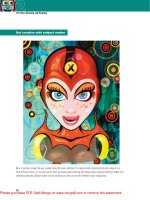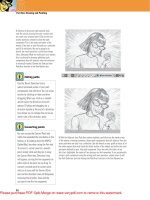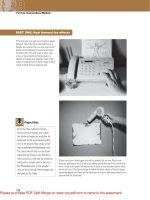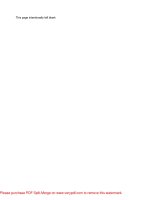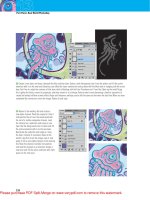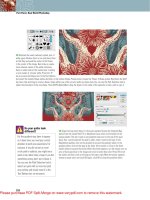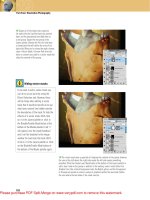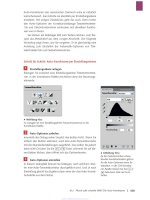Photoshop CS4 Studio Techniques- P14 ppt
Bạn đang xem bản rút gọn của tài liệu. Xem và tải ngay bản đầy đủ của tài liệu tại đây (1.66 MB, 30 trang )
376
Chapter 10 Collage Eff ects
Camera Raw
You can blend two different interpretations of the same
raw format image by using Smart Objects. Embed a
Camera Raw fi le into an existing document by choosing
File > Place. In the Camera Raw dialog, you can control the
tonality and color of the image—but what if you can’t fi nd
a single interpretation that does justice to the entire image
(Figure 10.33)? Choose Layer > Smart Objects > New
Smart Object via Copy to create a second Smart Object
that’s independent of the fi rst. Double-click the thumbnail
image for the new Smart Object, causing the Camera Raw
dialog to appear, and choose different settings that you
want to apply to the second Smart Object. Once you have
the two different interpretations of the raw fi le (Figures
10.34 and 10.35), you can add a layer mask to the top
Smart Object and use it to control where each version of
the raw fi le contributes to the fi nal image (Figure 10.36).
Figure 10.34 The sky was ignored
and the bottom was optimized in this
Camera Raw interpretation.
Figure 10.35 The bottom was ignored
and the sky was optimized in this
Camera Raw interpretation.
Figure 10.36 The two interpretations
of the same raw file were combined
by using a layer mask.
Figure 10.33 Using a single set of
Camera Raw settings produced this
less-than-desirable result.
(©2007 Ben Willmore.)
377
IV: Creative Techniques
Painting and Adjustments
Many of Photoshop’s tools are disabled when a Smart
Object is active in the Layers panel. Here are a few tricks
you can use to get around that limitation:
. To apply paint to a Smart Object, create a new layer
directly above the Smart Object and choose Layer >
Create Clipping Mask so that any paint applied to the
layer will show up only where the Smart Object appears.
. To adjust a Smart Object without affecting the rest of
the image, select the Smart Object layer, hold down
Option/Alt, click the Adjustment Layer pop-up menu
at the bottom of the Layers panel, and choose the
adjustment you want to apply. When the New Layer dia-
log appears, turn on the Use Previous Layer to Create
Clipping Mask check box to limit the adjustment to the
Smart Object layer.
. If you want to apply a fi lter that’s not available as a
Smart Filter, fi rst duplicate the Smart Object layer by
pressing Command/Ctrl-J, and then hide the original
by clicking its eyeball icon. Now apply the fi lter to the
duplicate. Photoshop merges the layers that make up
the Smart Object (also known as rasterizing), which
turns it into a normal layer. But since you hid the
original Smart Object, you still have a copy that you can
later edit and then re-fi lter.
. Be careful when adding layers to a Smart Object. If
the original Smart Object was created after opening
a fl at JPG fi le that contained no layers, adding lay-
ers will cause problems. Photoshop will act as if the
Smart Object is actually a JPG fi le. Since JPG fi les can’t
contain layers, Photoshop will present a Save As dialog,
forcing you to save the document in a fi le format that
supports layers. That means that adding a layer will
cause your edited Smart Object to be saved on your
hard drive instead of being embedded in the parent
document in which you used the Smart Object. To
update the parent document, choose Layer > Smart
Object > Replace Contents and point Photoshop to the
newly saved layered fi le.
378
Chapter 10 Collage Eff ects
Warping Images
Photoshop’s warping features allow you to bend and distort
images in interesting ways. Choosing Edit > Transform >
Warp causes various warp settings to appear in the options
bar (Figure 10.37) and places a grid over the active layer
(Figure 10.38). There are 15 preset warp shapes available
(Figure 10.39). After choosing a preset from the Warp
pop-up menu in the options bar, you can adjust the Bend,
H (Horizontal), and V (Vertical) fi elds in the options
bar to control the extent of the warp that’s applied to
the active layer. If you need to warp an image to match
an element in a photograph, set the Warp pop-up menu
to Custom.
Figure 10.37 The options available when warping a layer.
Figure 10.38 Choosing Edit > Transform > Warp causes a warp grid to appear
over the image. (©2008 Dan Ablan.)
Figure 10.39 The default warp
presets.
379
IV: Creative Techniques
When applying a Custom warp, you can drag the corner
points, handles, or grid lines to distort the image. To
match the contours of an object, start by positioning the
corner handles to meet the underlying image (Figure
10.40). Adjust the corner handles to specify the angle at
which the edge of the image should match the underly-
ing image (Figures 10.41 and 10.42). To fi ne-tune the
results, drag the grid lines until the image is distorted to
match the underlying object (Figure 10.43). If you warp a
Smart Object layer, you can choose Layer > Smart Object >
Replace Contents to swap out a different image while
retaining the warping last applied to the layer (Figures
10.44 and 10.45).
Figure 10.40 Choosing Custom from
the Warp pop-up menu presents a
grid.
Figure 10.41 Drag the four corners
of the grid so they line up with the
object you’re trying to match.
Figure 10.42 Adjust the corner
handles.
Figure 10.43 Fine-tune the results by
dragging the grid lines.
Figure 10.44 End result of warping
the image to match the page. (©2007
iStockphoto.com and Ben Willmore.)
Figure 10.45 Using a Smart Object,
you can swap the image while retain-
ing the warping.
380
Chapter 10 Collage Eff ects
Creating Complex Collages
Now we’re ready to put all these features together, com-
bine them with the blending modes we explored in
Chapter 9, and throw in a few other techniques to create
a complex collage. If you haven’t read through all of this
chapter and Chapter 9, it might be diffi cult to follow along
with this project, so make sure that you’ve covered that
material before you dive in.
The collage in Figure 10.46 was originally created by
Regina Cleveland for the CS2 edition of this book. She
challenged Ben Willmore to re-create it in Photoshop and
gave him a total of four photos, which she snagged from
www.istockphoto.com (Figures 10.47 to 10.50), along with
a shot of Ben taken by his friend Andy Katz (Figure 10.51).
Figure 10.47 This leaf image started
out as a black-and-white shot. (©2007
iStockphoto.com/BritishBeefUK.)
Figure 10.48 This pattern was used
on both the head and background.
(©2007 iStockphoto.com/LindaMarieB.)
Figure 10.50 The lens from this
camera was used in the center of
the image. (©2007 iStockphoto.com/
avarkisp.)
Figure 10.49 The head was isolated
from its background. (©2007
iStockphoto.com/puentes.)
Figure 10.51 This shot of Ben
Willmore goofing off was used as
a reflection in the lens. (©2007
Andy Katz.)
Figure 10.46 A collage on the cover
of a previous edition of this book.
381
IV: Creative Techniques
We’re going to fl y through this procedure, so pay close
attention!
Creating the Fan of Leaves
The fi rst element is the single leaf image, which, when
later multiplied, will provide a headdress for the face.
We double-click the Background image to turn it into a
normal layer, and then use a vector mask to isolate the leaf
from its background (Figures 10.52 and 10.53). Because
this element is going to be scaled and rotated many times,
and needs to retain as much of the original detail as pos-
sible, we convert the layer into a Smart Object.
The original leaf document doesn’t have enough space to
create the fan of leaves, so we create a new document the
exact size of the book cover plus nine points (just over 1/8
of an inch) of extra space on three sides to allow for bleed
(the fourth side will merge with the spine of the book and
therefore doesn’t need any bleed). Once the document
is open, we position three guides (using the View > New
Guide command) to indicate the trimmed page size. Then,
before doing any more work, we drag the leaf Smart Object
to the newly created document (using the Move tool) and
scale it to an appropriate size (using the Edit > Free Trans-
form command).
The fan needs a total of ten leaves spanning a 180-degree
arc. To space the leaves evenly, we divide the total degrees
of rotation (180) by the number of leaves that will be
used (9, since two of the leaves will end up at the same
angle—straight up and down—and therefore shouldn’t be
counted twice). Since dividing 180 by 9 produces 20, that
means that each leaf needs to be rotated by 20 degrees
from the one adjacent to it.
With those calculations in hand, we duplicate the original
Smart Object layer by pressing Command/Ctrl-J to create a
second instance of the Smart Object. We rotate the dupli-
cate by pressing Command/Ctrl-T to access the Free Trans-
form command; then the pivot point (which looks like a
crosshair and appears in the center of the layer that’s being
transformed) is dragged straight down and positioned on
Figure 10.52 Isolate the leaf from its
background by using a vector mask.
Figure 10.53 Layers panel view of the
isolated leaf.
382
Chapter 10 Collage Eff ects
the bottom center transformation point (Figure 10.54). To
get the proper amount of rotation, we enter a value of 20
in the Angle fi eld in the options bar, which ends up rotat-
ing the image to the right—the wrong direction. Oops!
Add a minus sign before the percentage to rotate it in
the opposite direction. After pressing Return/Enter twice
(the fi rst time to have Photoshop accept the number and
the second time to complete the rotation), we repeat the
process (duplicate, move pivot point, rotate) until a total
of ten leaves are in place (Figure 10.55).
Next, the leaves needed to interact with each other instead
of obscuring each other. For each layer, the blending mode
is set to Multiply, causing the layer to act as if it were being
printed on top of the underlying layers using ink (Figure
10.56). At this point, the fan of leaves starts to look inter-
esting, but lacks any hint of color.
Figure 10.54 The pivot point is
dragged to the tip of the leaf.
Figure 10.55 Result of duplicating
and rotating the leaf Smart Object
nine times.
Figure 10.56 The leaves look more
integrated after setting each Smart
Object layer to Multiply mode.
Color is added by applying a Gradient Overlay layer style
to each layer, using the Color blending mode to apply the
color of the active layer to the brightness information from
383
IV: Creative Techniques
the underlying image. In this case, Color mode causes
the Gradient Overlay to apply color to the brightness
values in the leaf. We click the Gradient Overlay Preview
and change the color used on one end of the gradient, and
then adjust the Opacity and Angle settings until the color
is affecting the leaf in just the right way (Figure 10.57).
To apply similar settings to the other leaf Smart Objects,
we Control/right-click the style-laden layer in the Layers
panel, choose Copy Layer Style, select all the other Smart
Object layers, Control/right-click one of the layers, and
choose Paste Layer Style, which makes all the leaves take
on the same color (Figures 10.58 and 10.59). To make
each leaf a different color, double-click the Layer Style icon
on each layer, change the color used in each gradient, and
adjust the Angle setting to cause the color to be concen-
trated near the outer tip of each leaf (Figure 10.60).
Figure 10.59 The leaves appear as a
single color because we applied the
same layer style to each leaf.
Figure 10.58 Copying and pasting
the layer style applies it to each of the
selected layers.
Figure 10.60 The leaves take on dif-
ferent colors after we modify the layer
style applied to each layer.
Adding the Head
At this stage, the fan of leaves is about done, but it lacks a
background. A stylistic head is the next element to tackle.
Figure 10.57 One of the Gradient Overlays that we
applied to the leaves.
384
Chapter 10 Collage Eff ects
We open the head image in Photoshop and drag it into
the book cover document, using the Move tool. A problem
develops after scaling the head layer to an appropriate size
and moving it to the bottom of the Layers stack: All the leaf
Smart Object layers look like they’re printed on top of the
head, because we set them all to use the Multiply blending
mode (Figure 10.61).
Since we needed the Multiply mode to cause the leaves
to print on top of each other instead of obscuring each
other, we select all the leaf Smart Object layers and choose
Layer > Smart Objects > Group into New Smart Object to
nest them into a new Smart Object. This solves the prob-
lem, because the individual layers that make up a Smart
Object cannot interact with layers that are outside the
Smart Object. A Smart Object can only interact with the
underlying image as a whole, and the blending mode for
the newly created Smart Object is set to Normal, which
prevents it from interacting with the rest of the image
(Figure 10.62). Grouping the leaf layers into a Smart
Object also has the added benefi t of greatly simplifying
the Layers panel.
The cover of this book traditionally features a white back-
ground, which means that the background of the head
image needs to be removed. We start by hiding the fan of
leaves Smart Object so it doesn’t obstruct the view of the
head layer. Removing the background on the head layer is
an easy process because the background is quite different
from the subject in both color and brightness. The Magic
Wand tool is perfect for this job. Clicking the background
probably isn’t enough to select the whole area, though,
so we hold down the Shift key and click unselected por-
tions of the background. It takes less than a dozen clicks
with the Magic Wand tool to get a decent selection of the
background. Then, to hide the background on the head,
hold down Option/Alt and click the Layer Mask icon at
the bottom of the Layers panel. Holding down Option/Alt
causes the selected areas to become hidden when the mask
is created (Figure 10.63). We might have to touch up a few
spots near the mouth and nose, since the original selection
isn’t perfect.
Figure 10.61 Set to Multiply mode,
the leaves look like they were printed
on top of the head.
Figure 10.62 The leaf layers are
grouped into a Smart Object, with
blending mode set to Normal.
Figure 10.63 The background is
removed from the head with the
Magic Wand tool and a layer mask.
385
IV: Creative Techniques
The head is now ready for her beauty treatment. The
paisley/fractal pattern image is placed on the layer directly
above the head. Then we choose Layer > Create Clipping
Mask to make the pattern show up only where the head
is (Figure 10.64). To make the pattern interact with the
head, we switch to the Move tool, hold down Shift, and
press the plus (+) key on the keyboard a few times to cycle
through all the blending modes in the pop-up menu at
the top of the Layers panel (Shift and the minus key cycles
back). After going through the whole list a few times, we
settle on the Overlay blending mode (Figure 10.65). The
improved look of the head is good, but the colors aren’t
popping the way they did in Regina’s original collage. With
the pattern layer still active, we choose Gradient Overlay
from the Layer Style pop-up menu at the bottom of the
Layers panel, created a colorful gradient, and then experi-
ment with the Blending Mode pop-up menu until we like
the results (Figures 10.66 and 10.67).
Figure 10.65 The Overlay blending
mode causes the pattern to overlay
onto the head.
Figure 10.66 Additional color comes
with a Gradient Overlay layer style on
the pattern layer.
Figure 10.64 A clipping mask is used
to make the pattern show up only
where the head is.
Figure 10.67 This Gradient Overlay is
applied to the pattern layer.
386
Chapter 10 Collage Eff ects
Adding the Camera Lens
At this point, we make the fan of leaves Smart Object vis-
ible again and reposition it so that the center of the fan
is close to being centered on the round part of the head
(Figure 10.68). To add the camera lens to the middle of
the fan, we open the photo of the camera, extract the
camera body from the lens by using a vector mask, and
then drag it into position within the collage. To add a little
accent to the lens, we choose Drop Shadow from the Layer
Style pop-up menu at the bottom of the Layers panel,
set the blending mode to Screen, and chose a cyan color
(Figure 10.69).
Figure 10.68 Result of repositioning
the fan of leaves.
Figure 10.69 We added the camera
lens and a Drop Shadow layer style.
Adding Type and Logo Treatments
It’s time to add the cover text, using four Type layers. (For
more about working with text, check out the bonus video
“Type and Background Effects” at www.danablan.com/
photoshop.) The logo that appears at lower right on the
cover was supplied by the publisher as an EPS fi le. To add
that element, we choose File > Place and point Photoshop
to the logo fi le. That embeds the EPS fi le into the collage as
a Smart Object layer, which allows it to be scaled to any size
without losing quality. To complete the graphic elements
on the cover, we add a red bar across the top of the docu-
ment, using the Rectangular Shape tool (Figure 10.70).
Figure 10.70 Text and logo treat-
ments are added to the cover.
387
IV: Creative Techniques
Creating the Background Texture
Now we’re ready to tackle the background behind the
head. The pattern applied to the head was the same used
for the background, so we duplicate the pattern layer, drag
it to the bottom of the Layers panel, and scale and position
it to fi ll most of the white space at the bottom of the image
(Figure 10.71). At this stage, the head and the background
contain similar colors, so we shift the color of the back-
ground: Hold down Option/Alt, choose Gradient Map
from the Adjustment Layer pop-up menu at the bottom of
the Layers panel, and turn on the Use Previous Layer to
Create Clipping Mask check box so the adjustment affects
only the background pattern. We added the gradient to
force the colors in the background toward red and orange
(Figures 10.72 and 10.73). To make the background fade
into the white found at the top of the cover, we add a layer
mask and apply a gradient to the mask (Figure 10.74).
Figure 10.73 Result of shifting the
colors in the background.
Figure 10.74 Result of masking the
background with a gradient.
Figure 10.72 A Gradient Map adjust-
ment layer shifts the background
colors toward red and orange.
Final Tweaks
The cover collage now contains all of the major pieces
found in the original version provided by Regina, and it
just needs a few tweaks to refi ne the results. For the back-
ground pattern, we duplicate the fan of leaves as a Smart
Object, setting its blending mode to Screen, lowering the
Figure 10.71 The pattern from the
head is duplicated and used as the
base of the background.
388
Chapter 10 Collage Eff ects
Opacity, and scaling it up to lighten the background, using
the same shape as the leaves. To make the fan of leaves
partially transparent, we add a layer mask and paint with a
soft-edged brush at a low opacity, which lets the shape of
the head show through. For the lens refl ection effect, we
add Ben’s photo above the lens and use Overlay blending
mode. Finally, to make a beam of light emanate from the
lens, we create a new layer, make a triangular selection and
fi ll it with white, and lower its opacity to connect the lens
to the eye (Figure 10.75). With a big “Whew!” we consider
the collage as fi nished, and now only need to put it into a
3-D mockup of the book’s cover.
Creating a 3-D Cover Mockup
To create the 3-D cover mockup, we use a photograph of
a similarly sized book, fl attening the newly created collage
and moving it into the book photograph image. Using the
Distort command (Edit > Transform > Distort), we distort
the collage to match the shape of the photographic cover
(Figure 10.76). Finally, we use the Gradient tool in Multiply
mode to add subtle shading to the cover, which adds a bit
of realism to the end result (Figure 10.77).
The Next Step
Hopefully you get as much of a kick out of creating col-
lages as we do. It’s one of those things that really never gets
old; you can always count on another surprise around the
corner, and knowing how to create a complex image like
this will help you to tackle whatever comes your way. If you
want to create truly realistic-looking collages, keep the fol-
lowing ideas in mind:
. When combining images that were shot under different
lighting conditions, be sure to color-correct the images
individually before turning them into a collage; other-
wise, each one will have a different color cast.
. If you’re basing a collage on an image that has a
desirable color cast (such as candlelight, fi relight,
or sunrise/sunset), use the techniques mentioned
Figure 10.75 The finished cover,
complete with lens reflection.
Figure 10.76 The transformed cover
image matches the perspective of the
photograph.
Figure 10.77 Shading with the Gradi-
ent tool helps to make the end result
look more realistic.
389
IV: Creative Techniques
in Chapter 8, “Color Manipulation,” to infuse all the
images with the same desirable color cast.
. When combining images, make sure that the direction
of the light in all the images is consistent; otherwise,
viewers will pick up on the fact that the image is a fake,
although they might not be able to pinpoint exactly
why they think that.
. The direction of the light should also dictate the direc-
tion in which shadows fall. Shadows should fall directly
opposite of the light source.
. When placing objects in a scene, think about where
each object appears in 3D space and make sure
that it has the appropriate focus compared to its
surroundings.
. The fi lm grain that shows up in an image is usually con-
sistent across the image, so either use the noise removal
techniques covered in Chapter 6, “Sharpening,” on
each image, or apply the Add Noise fi lter (Filter >
Noise > Add Noise) to make sure that all the images
have the same amount of grain.
If you keep these ideas in mind, with a little practice and
a lot of perspiration you should be able to create collages
that fool even a trained eye. Now, move on to the last
chapter, probably one of the most important subjects for
photographers, “Retouching Techniques.”
This page intentionally left blank
CHAPTER
11
Retouching Techniques
392
As long as the world is turning and spinning, we’re
gonna be dizzy and we’re gonna make mistakes.
—Mel Brooks
Retouching Techniques
I
f you’re brave enough to bring up the subject of retouch-
ing at a photographer’s convention, you’re likely to spark
a lively debate. A purist might say that every aspect of a
photograph (including the fl aws) is a perfect refl ection
of reality and you should never tamper with it. A graphic
artist, who makes a living from altering images, might say
that an original photograph is just the foundation of an
image, and that “tampering” is just a means of enhanc-
ing it. Either way, retouching photographs has become
an everyday necessity for almost anyone who deals with
graphic images. And when it comes to retouching, hands
down, nothing does it better than Photoshop.
Photoshop CS4 packs an awesome arsenal of retouching
tools. In this chapter, you’ll learn how to do all sorts of
neat things, including retouching old ripped photos, get-
ting rid of shiny spots on foreheads, adjusting the satura-
tion of small areas—even giving someone “instant plastic
surgery.”
Patch Tool
The Patch tool (hidden under the Healing Brush in the
Tools panel) is innovative yet simple. You select an area of
the image that needs to be touched up, such as a blemish,
tattoo, or logo you don’t have permission to use (Figure
11.1), click in the middle of the selection, and drag it to
an area of the image that has similar texture but without
whatever you’re trying to remove. As you move the mouse,
Photoshop previews the source area (from which you’re
copying) in the destination area you initially selected
While we’ll concentrate on touching
up faces, don’t forget that these
tools can be used on any type of
image. A stray light switch on a
wall detracting from the shot? No
problem—just use the Patch tool!
393
IV: Creative Techniques
(Figure 11.2). When you release the mouse button, Photo-
shop “patches” the destination area with the source area
(Figure 11.3), making sure that the brightness and color
is consistent with the edge of the original selection, and
blending the new texture with that edge. You simply have
to try it to see how cool it is.
Figure 11.1 Original image. (©2008
Dan Ablan.)
Figure 11.2 Drag the selection to an
area of clean texture.
Figure 11.3 The result of using the
Patch tool.
You can even sample from an area that’s radically differ-
ent in brightness and color (Figure 11.4), because the
Patch tool picks up only the texture from the area that it
samples (Figure 11.5). The main thing you should look for
is a source area that has the proper texture to match the
destination area you’re attempting to retouch.
Figure 11.5 Only the texture is copied.Figure 11.4 You can drag the selec-
tion to an area that contains radically
different colors and brightness.
(©2008 Dan Ablan.)
You still need to be careful when making selections. Try
for the smallest selection that will completely encompass
the defect you’re trying to retouch. The larger the area
being patched, the less likely it will look good (Figures 11.6
and 11.7).
394
Chapter 11 Retouching Techniques
Figure 11.6 Patching a large selection
makes the model’s inner arm look
artificial. (©2008 Dan Ablan.)
Figure 11.7 A small selection pro-
duces a nicer blend.
This tool doesn’t have many options (Figure 11.8). The
main choice is whether to patch the source or the destina-
tion. With the Patch option set to Source (which you’ll
probably use 95% of the time), Photoshop replaces the
area that was originally selected with a combination of
the brightness and color values from its edge, along with
the texture from the source area to which you drag the
selection (Figures 11.9 and 11.10). Using the Destination
setting does the opposite, letting you pick from a clean
area of the original and then dragging it over the area that
needs to be patched—for example, cloning a birthmark
(Figures 11.11 and 11.12).
Figure 11.8 The options bar for the Patch tool.
395
IV: Creative Techniques
Figure 11.11 Using the Destination
setting while dragging a clean area of
the skin to an area that needs retouch-
ing, or to replicate a birthmark.
Figure 11.10 The clean texture is
copied to the area under the eye and
blended automatically.
Figure 11.9 Using the Source setting
while dragging a birthmark from
under the eye to an area of clean
texture. (©2008 Dan Ablan.)
If you can’t fi nd a clean area from which to steal texture,
you can select a pattern by clicking the down arrow in
the options bar (Figure 11.13) and then clicking the Use
Pattern button. Patching with a pattern isn’t very effective
unless you’ve created a custom pattern for this specifi c pur-
pose. Check out the bonus video “Type and Background
Effects” at www.danablan.com/photoshop for details on
how to create your own patterns.
Figure 11.13 Choosing a texture.
The Patch tool is best for situations where you’re dealing
with scratches, blemishes, or other defects in an area that
should otherwise be relatively consistent in color (such
as skin). Used on walls, fl oors, automobiles, and so on, it
Figure 11.12 The birthmark is
blended into the surrounding image.
396
Chapter 11 Retouching Techniques
can even maintain some of the three-dimensionality of the
surface with its blending capabilities (Figures 11.14 and
11.15). But it’s not very useful for an area with multiple
colors that shouldn’t be blended. In that case, you should
switch to the Clone Stamp tool.
Figure 11.14 The original image.
(©Stockbyte, www.stockbyte.com.)
Figure 11.15 Three passes with the
Patch tool covered this large area.
If you use the Patch tool to remove all wrinkles and blem-
ishes from someone’s face, the person may no longer be
recognizable. When you retouch facial features, choose
Edit > Fade Patch Selection immediately after applying a
patch (Figure 11.16). This feature allows you to change
how the patch applies to the original image. Move the
Opacity slider all the way to the left and then slowly move it
toward the right until you reach the lowest Opacity setting
that lessens the look of the undesirable feature without
completely removing it (Figures 11.17 to 11.19). This
technique is essential when working with shiny skin. If you
use the Patch tool at full strength, you’ll lose the dimen-
sionality of the skin, but fading it back makes the area look
less shiny, without completely evening out the lighting on
the skin.
The Patch tool is most useful when working on large
areas; it’s just too cumbersome for retouching dozens
of small blemishes. For that situation, switch to the
Healing Brush, which can make those small retouching
jobs a breeze.
Figure 11.16 The Fade dialog.
An alternative to using the Fade
command is to duplicate the origi-
nal image layer before performing
retouching, and then adjust the
Opacity setting at the top of the
Layers panel to blend the retouched
layer with the underlying image.
Another alternative is to duplicate
the background layer and apply the
Patch tool on the duplicate. Then
fade the opacity of the layer to
reveal and blend the original layer
to your liking.
397
IV: Creative Techniques
Figure 11.17 The original image has
shiny patches on the model’s chin,
chest, right shoulder, and under her
right eye. (©2008 Dan Ablan.)
Figure 11.18 Using the Patch tool
at full strength reduces the shine
but removes some of the skin’s
dimensionality.
Figure 11.19 Result of fading each
application of the Patch tool to about
40% opacity.
Healing Brush
The Healing Brush works using the same general concepts
as the Patch tool. It attempts to patch a defect in the image
by using the texture from another area and blending all
the edges with the surrounding colors. The main differ-
ence between the two tools is that the Patch tool works by
moving a selection, whereas the Healing Brush allows you
to paint over the area that needs to be repaired.
To use the Healing Brush, Option/Alt-click the area you
want to use (Figure 11.20), usually a part of the skin or
surface that’s free of blemishes, and then click and drag
it onto the area that needs fi xing (Figure 11.21). Be sure
to cover the entire destination area without releasing the
mouse button. Once you release the mouse button, Photo-
shop checks the edges of the destination area you covered
to make sure that the “patch” blends with the color and
brightness of the surrounding area (Figure 11.22).
398
Chapter 11 Retouching Techniques
Figure 11.20 Option/Alt-click the
source area to sample it. (©2008 Dan
Ablan.)
Figure 11.21 Paint across the destina-
tion area that needs to be retouched.
Here we’re covering some tiny
dimpled areas on the model’s skin to
the right of her nose.
Figure 11.22 When you release the
mouse button, Photoshop blends the
retouched area into the surrounding
image.
You might need to use a soft-edged brush to get a good
blend (Figures 11.23 and 11.24). A good starting point is
to use a brush with a Hardness setting of 75%.
Figure 11.23 Result of using a hard-
edged brush under the model’s eye.
(©2008 Dan Ablan.)
Figure 11.24 The difference is very
subtle, but a soft-edged brush blends
the results better with the surround-
ing image than the hard-edged
brush does.
Layers
The Healing Brush works on one layer at a time, but you
can choose to sample other layers. In the options bar for
the Healing Brush, open the Sample drop-down menu
and choose Current Layer, Current & Below, or All Layers
(Figure 11.25). If you choose All Layers, Photoshop acts as
if the document has no layers at all. In other words, it will
be able to take from any layer below the cursor, as if all the
layers were combined. However, it will apply the healing
information only on the active layer.
Figure 11.25 The options bar for the Healing Brush.
Choose a brush from the Brush
drop-down menu in the options
bar. The Healing Brush ignores the
stand-alone Brushes panel because
it doesn’t use the advanced settings
available in that panel.
If you need a really soft brush (0%
hardness), use the Healing Brush
with its blending mode set to
Replace. That setting will make it
act like the Clone Stamp tool, but
it won’t produce blurry results with
soft-edged brushes.
399
IV: Creative Techniques
One handy option is to create a layer just for doing your
retouching. Then you won’t have to worry about making
a mistake as you work, because the information you’re
retouching is sitting on its own layer, with the unretouched
image directly below it (Figures 11.26 to 11.28). This tech-
nique allows you to switch over to the Eraser tool and erase
small areas of that layer, or do other things such as lower
the opacity of the layer.
Figure 11.27 The underlying image is
unaffected under the retouching layer.
(©2008 Dan Ablan.)
Figure 11.28 By retouching on an
independent layer, you can sample
from all layers, but also vary the opac-
ity of each layer.
Blending Modes
A few blending modes, such as Multiply, are available in
the options bar, but they work a little differently than
usual. Most tools apply their general effect, and then,
once everything is done, they apply the blending mode.
But with the Healing Brush, the blending mode is applied
before Photoshop does the work needed to blend the
patched area with the surrounding image (Figures 11.29
and 11.30).
Figure 11.29 This is how Multiply
mode would usually look for decreas-
ing the hotspot on the model’s cheek.
(©2008 Dan Ablan.)
Figure 11.30 This is how Multiply
mode looks when using the Healing
Brush.
Figure 11.26 Retouch on a new layer
to isolate your retouching from the
underlying image.
400
Chapter 11 Retouching Techniques
Spot Healing Brush
The Spot Healing Brush makes quick work of removing
tiny defects in most images. It uses the same concepts as
the Healing Brush and the Patch tool. The only difference
is that it doesn’t require you to choose an area of clean
texture to copy. All you have to do is click and drag over a
defect that needs to be removed; Photoshop analyzes the
surrounding area and attempts to fi nd appropriate texture
to borrow. When you click and drag, the area that will be
retouched is covered in black. When you release the mouse
button, you’ll see the results of the retouching (Figures
11.31 and 11.32). If the results don’t look good, try drag-
ging over the defect a second time, and Photoshop will
pull from a different area.
If no clean areas of texture surround the defect you’re
attempting to retouch, try using the Create Texture
setting in the options bar (Figure 11.33), which will
cause Photoshop to create its own texture based on the
surrounding image. This setting is especially useful on
images that are scratched or that have a lot of detail in the
surrounding area.
Figure 11.33 The Spot Healing Brush settings in the options bar.
When you’ve reached the point where you think you’re
done working on an image, zoom in to 100% magnifi ca-
tion (by double-clicking the Zoom tool) and look for any
tiny defects in the image (such as dust, scratches, or pin-
holes), and fi x them with the Spot Healing Brush.
The Patch tool, Healing Brush, and Spot Healing Brush
are useful only when the area that needs to be retouched
should match the color and brightness of the areas that
surround it. When you run across an area that shouldn’t
blend into its surroundings, you’ll have to switch over to
the trusty standby—the Clone Stamp tool.
Press the Home key (available on
most extended keyboards) to get to
the upper-left corner of the image.
Then use Page Up and Page Down
to move one full screen up or down
(add Shift to move less than one
full screen). Add Command/Ctrl to
Page Up and Page Down to move
one full screen to the right or left.
Figure 11.31 This image is scratched.
(©2008 Dan Ablan.)
Figure 11.32 The scratch disappears
seamlessly when painted over with
the Spot Healing Brush.
